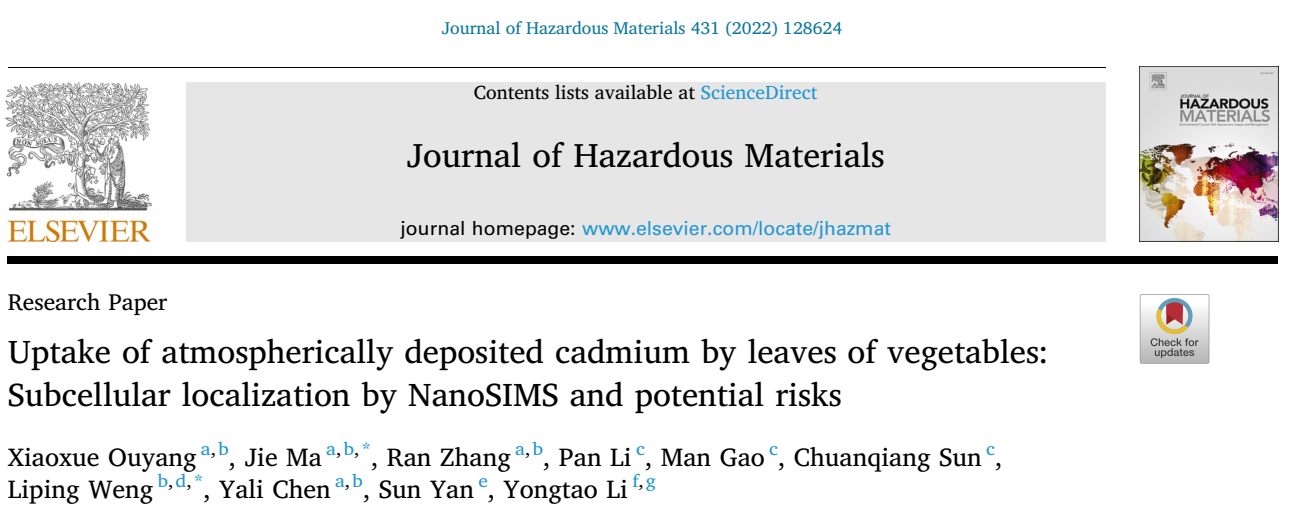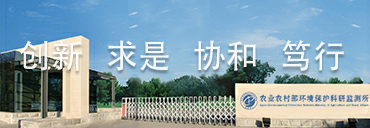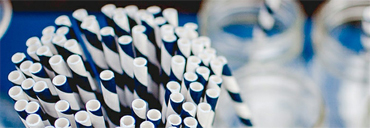Journal of Hazardous Materials:揭示叶菜作物对大气沉积镉的吸收、转运、积累和毒性机制及人类食用的健康风险
作者: 来源:农田有机污染生物消减创新团队 2022-10-21
Journal of Hazardous Materials:揭示叶菜作物对大气沉积镉的吸收、转运、积累和毒性机制及人类食用的健康风险

话题:纳米镉,叶面吸收,毒性,健康风险
大气Cd沉降是农田生态系统Cd的重要来源,可通过根系和叶片吸收途径进入作物并在作物中积累,经食物链威胁人类的健康。与已被大量研究的作物根系吸收、转运Cd不同,叶片对大气沉降Cd的吸收、转运过程尚缺乏系统的研究。本研究利用纳米硫化镉(CdSN)模拟大气沉降Cd,以常见空心菜和油菜为实验对象开展叶面盆栽试验,通过对作物不同营养器官的Cd含量分析,并运用亚细胞分析、高分辨率二次离子质谱(NanoSIMS)等手段,阐明了两种作物叶面对Cd的吸收、转运、积累机制和毒性特征。相关成果有助于我们了解大气中Cd在植物中的累积、转运机制,评估Cd通过食物链转移的潜在风险。
相关成果发表于SCI期刊Journal of Hazardous Materials(IF= 14.224)。
农业农村部环境保护科研监测所博士研究生欧阳小雪为论文第一作者,马杰副研究员和翁莉萍研究员为论文共同通讯作者。该研究得到了国家自然科学基金和农业农村部环境保护科研监测所基本科研业务费项目的资助。
DOI: 10.1016/j.jhazmat.2022.128624
Atmospherically deposited cadmium (Cd) may accumulate in plants through foliar uptake; however, the foliar uptake, accumulation, and distribution processes of Cd are still under discussion. Atmospherically deposited Cd was simulated using cadmium sulfide (CdS) with various particle sizes and solubility. Water spinach (Ipomoea aquatica Forsk, WS) and pak choi (Brassica chinensis L., PC) leaves were treated with suspensions of CdS nanoparticles (CdSN), which entered the leaves via the stomata. Cd concentrations of WS and PC leaves treated with 125 mg L−1 CdSN reached up to 39.8 and 11.0 mg kg−1, respectively, which are higher than the critical leaf concentration for toxicity. Slight changes were observed in fresh biomass, photosynthetic parameters, lipid peroxidation, and mineral nutrient uptake. Exposure concentration, rather than particle size or solubility, regulated the foliar uptake and accumulation of Cd. Subcellular and the high-resolution secondary ion mass spectrometry (NanoSIMS) results revealed that Cd was majorly stored in the soluble fraction and cell walls, which is an important Cd detoxification mechanism in leaves. The potential health risks associated with consuming CdS-containing vegetables were highlighted. These findings facilitate a better understanding of the fate of atmospheric Cd in plants, which is critical in ensuring food security.
Keywords:
CdS nanoparticles; foliar uptake; phytotoxicity; Subcellular distribution; NanoSIMS; Health risk

主要研究结果:纳米硫化镉(CdSN)通过气孔进入空心菜和油菜叶片,部分被固定在叶片细胞内(主要细胞壁),其余部分被转运至植物的根、茎中,最终导致空心菜和油菜组织中Cd浓度增加。125 mg L−1 CdSN处理时,空心菜和油菜叶片Cd浓度分别达到39.8 mg kg−1和11.0 mg kg−1,为对照的100倍和36倍,高于叶片毒性临界浓度。空心菜和油菜的鲜重、光合参数、酶活性和矿质养分吸收无明显差异,但高Cd浓度处理组空心菜和油菜的日污染物摄入量(EDIs)为日可耐受摄入量(TDI)的2.35~8.61倍,且非致癌风险指数(HQ)值均高于1,表明食用这些被污染的蔬菜将导致严重的健康风险。暴露浓度控制Cd的叶片吸收和积累,而颗粒大小或溶解度对吸收和积累贡献不大。亚细胞和NanoSIMS结果表明,Cd主要储存在叶片的细胞壁和可溶性部分中,这是叶片Cd解毒的重要机制。
环境意义:叶片吸收是植物吸收大气沉降中重金属的方式之一。我们的研究结果表明了大气沉积Cd可以经气孔途径进入作物叶片,导致污染物在叶片中积累,引起作物毒性反应,并对食物产量和质量产生潜在风险。CdSN在空心菜和油菜叶片细胞壁的固定,减少了Cd转运到其他组织中。然而,由纤维素和基质多糖(果胶和半纤维素)组成的细胞壁是重要膳食纤维的来源,Cd在细胞壁的过量积累增加了Cd进入食物链的风险。另外,重金属在叶片吸收后会发生形态变化,影响其在植物内部的生理生化行为。因此,需要进一步研究以明晰Cd在植物中的形态变化。













